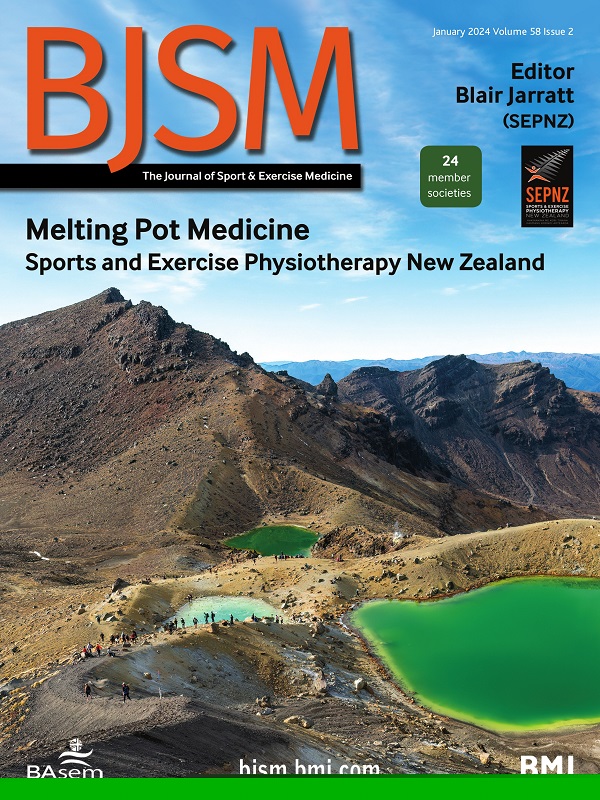WHO guidelines on waist circumference and physical activity and their joint association with cancer risk
IF 11.6
1区 医学
Q1 SPORT SCIENCES
引用次数: 0
Abstract
Objective Low body fat and high physical activity levels are key lifestyle factors in cancer prevention, but the interplay of abdominal obesity and physical activity on cancer risk remains unknown. We explored individual and joint associations of waist circumference and physical activity with cancer risk. Methods Using UK Biobank data (n=315 457), we categorised individuals according to WHO guideline thresholds for waist circumference and self-reported physical activity levels. Multivariable-adjusted Cox regression was used to estimate HRs and 95% CIs of total cancer. The reference group comprised individuals with recommended levels of waist circumference (<88 cm for women and <102 cm for men) and physical activity (>10 metabolic equivalent of task hours/week). Furthermore, we estimated the proportion of cancers attributable to abdominal obesity and insufficient physical activity. Results During a median follow-up period of 11 years (3 321 486 person-years), 29 710 participants developed any type of cancer. Participants not meeting the WHO guideline on waist circumference had increased cancer risk, even when sufficiently physically active according to the WHO (HR 1.11, 95% CI 1.08 to 1.15). Similarly, individuals not achieving the WHO guideline for physical activity showed an elevated risk, even if they were abdominally lean (HR 1.04, 95% CI 1.01 to 1.07). Not adhering to either guideline yielded the strongest increase in risk (HR 1.15, 95% CI 1.11 to 1.19). We estimated that abdominal obesity coupled with insufficient physical activity could account for 2.0% of UK Biobank cancer cases. Conclusion Adherence to both WHO guidelines for waist circumference and physical activity is essential for cancer prevention; meeting just one of these guidelines is insufficient. Data may be obtained from a third party and are not publicly available. The data that support the findings of this study are available from the UK Biobank but restrictions apply to the availability of these data, which were used under license for the current study, and so are not publicly available. Researchers will need to apply to access the UK Biobank database at the following link:世卫组织关于腰围和身体活动及其与癌症风险联合关系的指南
目的低体脂和高体力活动水平是预防癌症的关键生活方式因素,但腹部肥胖和体力活动对癌症风险的相互作用尚不清楚。我们探讨了腰围和体力活动与癌症风险之间的个体和联合关系。方法使用UK Biobank数据(n=315 457),根据WHO腰围指南阈值和自我报告的身体活动水平对个体进行分类。采用多变量校正Cox回归估计总癌症的hr和95% ci。参照组由具有推荐腰围水平的个体组成(10代谢当量的工作小时/周)。此外,我们估计了归因于腹部肥胖和身体活动不足的癌症比例。结果在11年的中位随访期间(3 321 486人年),29 710名参与者患上了各种类型的癌症。不符合世界卫生组织腰围指南的参与者患癌症的风险增加,即使根据世界卫生组织的规定,他们进行了充分的体力活动(HR 1.11, 95% CI 1.08至1.15)。同样,未达到世卫组织身体活动指南的个体,即使他们腹部较瘦,也显示出较高的风险(HR 1.04, 95% CI 1.01至1.07)。不遵守任何一项指南都会产生最大的风险增加(HR 1.15, 95% CI 1.11至1.19)。我们估计腹部肥胖加上身体活动不足可能占英国生物银行癌症病例的2.0%。结论:遵守世界卫生组织腰围和身体活动指南对预防癌症至关重要;仅仅满足其中一条准则是不够的。数据可能会从第三方获得,并且不会公开提供。支持本研究结果的数据可以从英国生物银行获得,但这些数据的可用性受到限制,这些数据是在当前研究的许可下使用的,因此不能公开获取。研究人员需要通过以下链接申请访问英国生物银行数据库:。
本文章由计算机程序翻译,如有差异,请以英文原文为准。
求助全文
约1分钟内获得全文
求助全文
来源期刊
CiteScore
27.10
自引率
4.90%
发文量
217
审稿时长
3-8 weeks
期刊介绍:
The British Journal of Sports Medicine (BJSM) is a dynamic platform that presents groundbreaking research, thought-provoking reviews, and meaningful discussions on sport and exercise medicine. Our focus encompasses various clinically-relevant aspects such as physiotherapy, physical therapy, and rehabilitation. With an aim to foster innovation, education, and knowledge translation, we strive to bridge the gap between research and practical implementation in the field. Our multi-media approach, including web, print, video, and audio resources, along with our active presence on social media, connects a global community of healthcare professionals dedicated to treating active individuals.

 求助内容:
求助内容: 应助结果提醒方式:
应助结果提醒方式:


